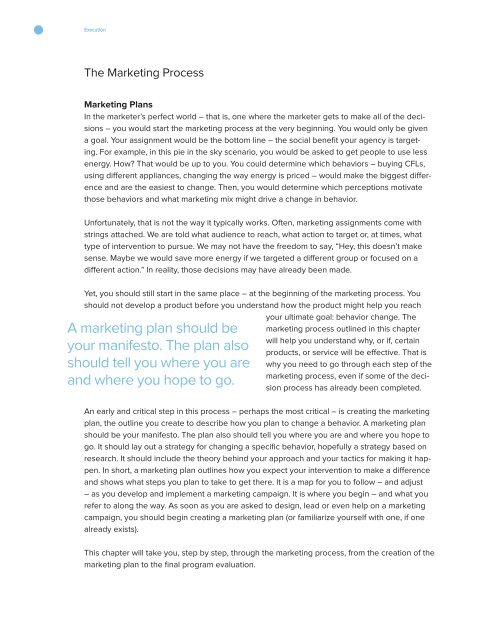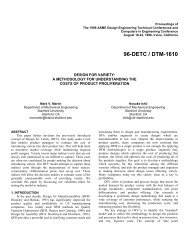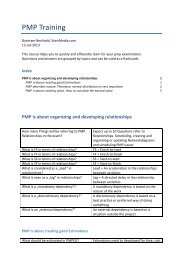Social Marketing
You also want an ePaper? Increase the reach of your titles
YUMPU automatically turns print PDFs into web optimized ePapers that Google loves.
Execution<br />
The <strong>Marketing</strong> Process<br />
<strong>Marketing</strong> Plans<br />
In the marketer’s perfect world – that is, one where the marketer gets to make all of the decisions<br />
– you would start the marketing process at the very beginning. You would only be given<br />
a goal. Your assignment would be the bottom line – the social benefit your agency is targeting.<br />
For example, in this pie in the sky scenario, you would be asked to get people to use less<br />
energy. How? That would be up to you. You could determine which behaviors – buying CFLs,<br />
using different appliances, changing the way energy is priced – would make the biggest difference<br />
and are the easiest to change. Then, you would determine which perceptions motivate<br />
those behaviors and what marketing mix might drive a change in behavior.<br />
Unfortunately, that is not the way it typically works. Often, marketing assignments come with<br />
strings attached. We are told what audience to reach, what action to target or, at times, what<br />
type of intervention to pursue. We may not have the freedom to say, “Hey, this doesn’t make<br />
sense. Maybe we would save more energy if we targeted a different group or focused on a<br />
different action.” In reality, those decisions may have already been made.<br />
Yet, you should still start in the same place – at the beginning of the marketing process. You<br />
should not develop a product before you understand how the product might help you reach<br />
your ultimate goal: behavior change. The<br />
A marketing plan should be<br />
your manifesto. The plan also<br />
should tell you where you are<br />
and where you hope to go.<br />
marketing process outlined in this chapter<br />
will help you understand why, or if, certain<br />
products, or service will be effective. That is<br />
why you need to go through each step of the<br />
marketing process, even if some of the decision<br />
process has already been completed.<br />
An early and critical step in this process – perhaps the most critical – is creating the marketing<br />
plan, the outline you create to describe how you plan to change a behavior. A marketing plan<br />
should be your manifesto. The plan also should tell you where you are and where you hope to<br />
go. It should lay out a strategy for changing a specific behavior, hopefully a strategy based on<br />
research. It should include the theory behind your approach and your tactics for making it happen.<br />
In short, a marketing plan outlines how you expect your intervention to make a difference<br />
and shows what steps you plan to take to get there. It is a map for you to follow – and adjust<br />
– as you develop and implement a marketing campaign. It is where you begin – and what you<br />
refer to along the way. As soon as you are asked to design, lead or even help on a marketing<br />
campaign, you should begin creating a marketing plan (or familiarize yourself with one, if one<br />
already exists).<br />
This chapter will take you, step by step, through the marketing process, from the creation of the<br />
marketing plan to the final program evaluation.

















